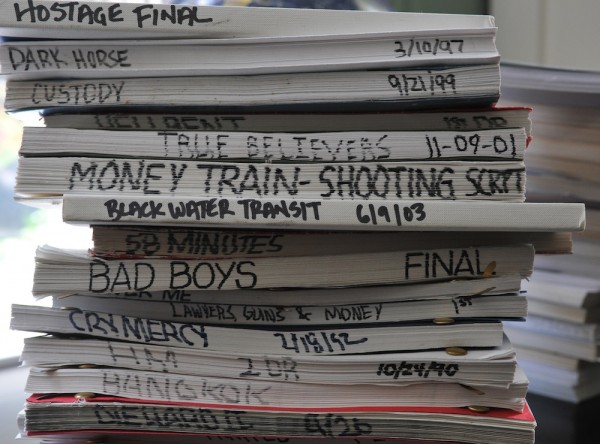How do you know when it’s time to put down a script, and write something else?
How do you stay motivated, and not get discouraged when a script doesn’t have the life you wanted it to have?
How long should it take to write a script, and how many projects do you work on at once?
These are common questions that most writers grapple with. My consulting and coaching clients often ask my take on them. And I give advice based on my own personal experience:
Write two scripts a year.
Here’s why:
I have worked on screenplays for a couple years or more, in the past, only to have not much come of them. This is a common experience for screenwriters. Then I saw something Steven Pressfield wrote about finishing something every six months. Maybe it was in his great book THE WAR OF ART — which I think all writers should read, regardless, on the subject of pressing on despite the inner resistance and self-doubts we all feel. Wherever it was, it clicked. Surely I could do that!
So how does this work?
Well, first we have to define “finish.” One of the banes of our existence as writers in film and TV is that it can seem like a project is never done. There are always more notes people will have, always more rewrites you could do. ALWAYS. And I’m talking right into production, and even in post-production! So I don’t mean “finish” in that sense, meaning that no changes will ever be made again.
But I also don’t mean a first draft you wouldn’t dare show anyone. I’m talking about a version that has gone through multiple internal rewrites based on your own notes after reading it. And possibly (POSSIBLY) getting a few people’s opinion at some point in the middle, and factoring their notes into your own work toward a next draft.
The idea here is that, after six months, you’ve had some perspective on it, you’ve done some rewriting, you’ve even taken a break in the middle for a while to get perspective on it, before returning to it with fresh eyes. And now you feel it’s ready to show the world.
That break in the middle is key.
Most of us know that one of the hardest things in this field is maintaining objective perspective on our work, and balancing others’ feedback with our own instincts, tastes and voice. The break in the middle really helps with that. And that’s maybe the best thing about this “2 scripts a year” approach. In my experience, I can get to a draft that I feel is relatively solid in maybe half that time. Then I put it down, and spend three months on another project — either a new one, or a rewrite of one in progress. Then, when I come back to the first script, it’s like, “Dear God, what was I thinking?” I have a lot of notes for myself. But hopefully, I feel there’s still something there, just with more work to be done. And that’s what the rest of the six months are for.
I’m not saying that the product of six months is going to be the best version of the script possible. But at that point, I move on to the next one, and I start to send the “finished” one out into the world. If I get strong interest somewhere, and that interest comes with “notes” (which it always does), then i would consider putting more time into it. Or if somebody just has great ideas for it that I vibe with, that make me want to work on it some more, that’s possible, too. But those things might not happen at all. There might not be much interest. It might not really go anywhere. And you know what?
I don’t care as much as I used to.
Because not only am I already onto my next one, I probably have another one in progress, as well as other finished ones from before. I have options. I’m not stuck on any one thing. And although they’re all my “baby” while I’m working on them, it’s easier to have a healthy relaxed attitude about the fate of any one of them, when there are so many others.
This, to my mind, is a professional approach. And if you have a manager or agent, they will strongly support it. They like a client to have multiple “planes circling the runway,” to borrow a phrase one of my CAA agents once used.
Does six months sound awfully short? How many hours per day or week does that entail, you ask?
That’s a great and relevant question. And I would say… it depends. The pace with which a writer can recognize a worthwhile idea, get it on its feet in outline form, and then a draft — that’s highly variable. You get better at these things (hopefully) with experience. But I would maintain that with the right focus, and the ability to recognize and put out reasonably workable material, one can work an hour a day, five days a week, and achieve this. The key is really making that time sacred, and keeping at it. And knowing what the plan is each day before you start, so that you can move forward productively with minimal time wasted.
And it means battling the demons that say you’ll never amount to anything and this isn’t a good idea, and putting them down rather quickly each day. Which is maybe the most important thing of all. And on that topic, did I mention that you should read THE WAR OF ART?



One hour a day, huh? That sounds doable.
I got bogged down with a script that I was devoted to, absolutely in love with, but could not figure out how to make the danged thing actually work. (Neither could anyone who read it, which calls into question my love.) I guess I kept thinking, this draft, I’ll figure it out. Also, I loved it so, I wanted to figure it out. But, I would have been better advised to put it aside (which I now have) and work on other scripts – get some more story chops working on other stories rather than keep banging my head against that wall.
This is a good approach. For my MEECHTA FIRST MOVE ADVANTAGE, pilot script, I spent a week on a sufficiently detailed step-plan of an outline (teaser > act 1 > act 2 > act 3 Act 4 > tag (7 scenes/beats/events per act, the primary story covering the breaks)), and another two on the writing of the script. I outlined MEECHTA PYRAMIDAGRAD, in about a week, and set the outline aside, to get on with the outline for the next episode. Now writing up the PYRAMIDAGRAD script. When I say script, they are narratives organised as TV episodes, until such times as a script is required. This lets me publish the episodes as an Amazon Kindle, to actually have product out, in the market, instead of scripts that are in a drawer or out-and-about, for evaluation. Coincidentally, via scriptshadow, I have read that the scripts for The Quiet Place, Meat, for example, run to under 70-pages, and that this is the latest trend. if so, it would mean that the output of scripts — all things being equal — could be more, than two a year.
Circling planes eventually run out of fuel. You have to land the plane or you’re just creating space junk.
True enough. What he probably meant was “some on the runway, some at the gate, some still circling,” etc. 🙂
Absolutely spot on, Erik. I remember my first screenplay (a few years ago) thinking that it was going to be the best think since, well you know the rest. Now five projects later, three of them circling that “field”, there is so much less pressure. Keep your options open.
I try not to quit working a script until I’ve written the whole thing, bad as it may be. If it got out of the outline stage, it hopefully has merit, and if I find that it’s flawed, I want to stick with it until I figure out the flaw and how to fix it. That said, I can put it down and start a new one when the draft is as done as I can make it at the time, even if I know I’ll have to come back to it.
That way I avoid all the temptations of a new idea, new characters, and other reasons for starting something new without having learned what I need from the previous one. It’s way too easy to turn out dozens of opening scenes, and miss out on making the connection between them and the final one if you never get there.
I have learned a HUGE amount from critiquing other people’s scripts, too. I try always to do this in question format (e.g., “Why does this reaction seem false?” or “How can you make this conflict more personal? or surprising?”) because I know those questions will help me edit myself, as well as allow the author to solve the problem for himself.
I’ve thought about this question of when to move on quite a bit. Lately I’ve been thinking I should be able to write two scripts a year but thought maybe that was an arbitrary quota. This post convinces me I’m on the right track. Thanks, Erik.